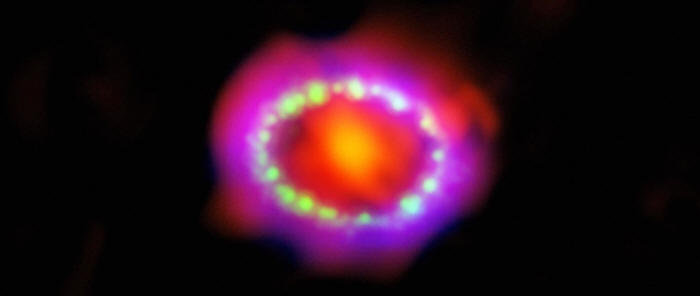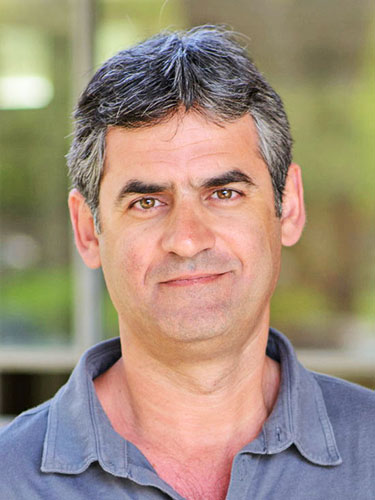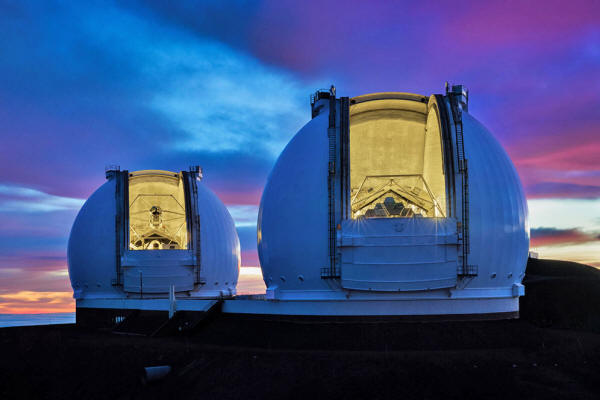|
from QuantaMagazine Website
show newly formed dust in the center (red) surrounded by the supernova's shock wave as it collides with gas around the supernova (blue and green). The image here is a composite of images from the Atacama Large Millimeter/submillimeter Array telescope in Chile (red), the Hubble Space Telescope (green)
and
Chandra X-ray Observatory (blue).
were able to train their telescopes on a recent eruption just hours after it exploded. What they found only adds to the growing list of questions
surrounding these cosmic
blasts.
The casualty was a star in a spiral galaxy some 160 million light-years away. Its core collapsed in on itself, triggering a supernova explosion as bright as 100 billion suns.
On a cosmic scale, this star was rather ordinary, probably a red supergiant some 10 times more massive than our sun.
But on October 6, 2013,
when the light from the explosion finally reached Earth, its death
made history. The glow from
SN 2013fs, as it's now called, hit the
right robotic witness, and then astronomers caught a cosmically
lucky break.
In A.D. 185, observers in China (and possibly Rome) recorded a bright "guest star" that shone for eight months. To Renaissance astronomers like Tycho Brahe and Johannes Kepler, these sudden heavenly bursts proved that the sky was not immutable. Modern astronomers study supernovas to understand how they seed the universe with heavy elements that can't be made otherwise.
But despite all the
attention, supernovas are still riddles wrapped in mysteries.
But the details of this process are still opaque.
The questions are compounded by the fact that supernovas are hard to find and even harder to study in detail.
Supernovas only happen about once or twice per galaxy per century - our Milky Way is now hundreds of years overdue for one - and appear to flash at random. Astronomers have to cast a wide celestial net and wait to see what they catch.
Then, as soon as a promising blast has been spotted, they try to secure time on a large, powerful telescope to study the event's spectrum of light, its astrophysical fingerprint. Often this means a wait of weeks, if not months.
By then the fireworks may have flickered out.
is an astrophysicist at the Weizmann Institute of
Science.
This time, astronomers got that final look.
Three hours after the first light from SN 2013fs reached Earth, an automated sky survey, the Palomar Transient Factory in Southern California, spotted the bright flash. By sheer luck, a team of supernova hunters had already pre-booked time on the massive Keck Telescope in Hawaii for that same night.
They had been planning to make a completely different set of observations, but now Ofer Yaron, an astrophysicist at the Weizmann Institute of Science in Israel, and his collaborator Dan Perley, a researcher at the California Institute of Technology, pointed Keck at the flare.
Yaron's team also lined up the space-based Swift telescope to take measurements in X-ray and ultraviolet light.
What they found is challenging long-held beliefs about how supernovas behave.
Yet SN 2013fs may have shown signs that it was about to die just several months before the eruption.
And once we understand how to spot these signs early, maybe we can predict which stars are about to blow up.
The First Burst
When Yaron and his team examined the early data from SN 2013fs, they saw that the exploding star was surrounded by a dense shell of gas.
This raised a question:
The traditional theory of core-collapse supernovas implies that a star should look outwardly quiet while its insides obliterate.
It's the core of the star that collapses, after all - the outer part of the star, called the mantle, only bursts once the collapsing core has rebounded against itself.
Over the past decade, however, a number of research teams have suggested that dying stars slough off their outer layers of gas before exploding.
One team, who sifted through Palomar images of 16 older supernovas, spotted minor flashes at five of them during the months immediately before detonation.
Lucy Reading-Ikkanda/Quanta Magazine
Yaron's observations of SN 2013fs appear to provide the clearest evidence that a dying star anticipates its imminent death by shedding more gas than usual during its final months.
Yaron compared the presence of the gas cloud to,
Five days later, as the shock wave from the supernova spread, this so-called circumstellar material had completely vanished.
Yet not all astronomers believe that the gas surrounding SN 2013fs was of a recent vintage.
Red supergiant stars - the kind that gave rise to SN 2013fs,
For instance, the red supergiant Betelgeuse in the constellation Orion is only 430 light-years away from us, so astronomers can see clearly that it is shrouded by gas that has likely been there for a long time.
One day, Betelgeuse will explode as a supernova, said Dessart - but can we predict if it will happen next year?
One way to be sure is to measure how fast the gas is moving away from the star. If it's moving quickly, it must have erupted recently.
Yaron said that in SN 2013fs,
But the measurements made by Keck provide only an upper limit on what the velocity of the gas is, not the exact number.
Based on the spectra, one simply cannot tell if the gas moved at a speed of "one, 10 or 100 kilometers a second," said Anders Jerkstrand.
In other words, the gas could have been floating around the progenitor star for many, many years.
The twin telescopes of the Keck Observatory
sit atop Mauna Kea in
Hawaii.
It could also be that the star that became SN 2013fs simply had an eruptive process completely unrelated to its core collapse, argued Jerkstrand.
After all, scientists have traditionally assumed that it's very unlikely for a star's core to "communicate" its imminent collapse to the hydrogen mantle - the star is so large and massive that it should take information thousands of years to travel from the core to the surface.
That's true if we assume that information is carried by photons of light, which bounce around in the optically thick environment of a star. Shock waves, however, could carry enough energy to create massive surface bubbling, said Fuller.
In April of this year, Fuller published a study (Pre-Supernova Outbursts via Wave Heating in Massive Stars I - Red Supergiants) that explores the idea of information transfer, but with a twist.
Fuller used an idea first put forward in 2012 by Eliot Quataert (Wave-driven Mass Loss in the last year of Stellar Evolution - Setting the stage for the Most Luminous Core-Collapse Supernovae), an astrophysicist at the University of California, Berkeley, who suggested that acoustic waves from the center of a star could trigger surface outbursts.
The core is,
It's the same with the star's core right before a star goes supernova:
The waves create little outbursts on the surface that,
His model supports Yaron's analysis of the gas found around SN 2013fs.
Supernova Inside Out
Early spectra, however, tell us only about the outside of the exploding star.
To see what's inside and get clues on why it blows up, you need to study a supernova from about 200 days after the explosion, during its so-called nebular phase, and much later, during the remnant phase, explained Jerkstrand.
By this time, the "ejecta" - the shreds of the star - have made it out to where they can be seen.
In a sense, the star has been turned inside out. These parts form the heavy elements that are the building blocks of much of our universe - including life.
One remnant that is currently forming right before our eyes (Supernova 1987A - Thirty Years Later) is that of SN 1987A - the nearest supernova to Earth in over 400 years.
Back in 1987, the event appeared to confirm one of the central insights into how stars explode.
Theories of Type II supernovas like SN 1987A predict that the collapse of the star's core will trigger a massive stream of neutrinos, a type of subatomic particle. And, indeed, two neutrino experiments on Earth independently detected a surge of these particles passing through our planet.
Neutrinos are famously shy, interacting only through the so-called weak force. But in recent years theorists have explored how they could change the supernova itself.
Because there are so many neutrinos coming out of a supernova's core, if even a small fraction of them are reabsorbed by the matter surrounding the core, the energy input will make the gas,
This animation is an artist's impression
of the explosion
and aftermath of supernova 1987A. Music: Geodesium and Mark Mercury.
Computer simulations of supernovas in 3-D reproduce this process with its,
These models seem to agree with what is happening in real time in SN 1987A.
In February, new images of SN 1987A were released by a team that combined data from three telescopes:
The images highlighted a striking observation of another important consequence of supernovas - freshly formed dust.
In the 30 years since, the gas cooled down to a few tens of Kelvins, so what were initially,
That makes it possible to detect molecules from the supernova - the astrophysical seeds of new stars and planets.
The Black Hole Option
Astronomers have cataloged a veritable zoo of different types of supernovas - from the thermonuclear explosions seen in Type Ia, to Types Ib, Ic, II-P, TI-P, II-L, IIn and more.
Because of this, we probably should not be surprised when newly discovered supernovas don't fit the categories that have been described before.
Compare SN 1987A and SN 2013fs, for example - both Type II "core collapse" supernovas.
The latter appears to provide the best evidence for some sort of anticipatory eruption on the star's surface. Yet take all we know about SN 1987A, and it quickly becomes clear that in this case the star's surface did not show any signs of its imminent death.
Woosley believes that this may not necessarily be a contradiction, but could simply point to new subclasses of supernovas, where some show early outbursts.
Both 1987A and 2013fs are also dramatically different from another class of core-collapse supernovas that was discovered only during the past decade - the incredibly energetic superluminous supernovas.
They,
So far, nobody knows exactly what they are or what causes them.
They are far too energetic to be powered by neutrinos like regular Type II supernovas. One idea currently gaining traction is that superluminous supernovas are supercharged by magnetars - rapidly rotating magnetic neutron stars.
These magnetars could form after a normal core collapse and then,
Little wonder that these extremely bright events cause major controversies.
In 2015, a team of researchers discovered what they said was the "most luminous supernova" ever, calling it ASASSN-15lh.
Yet, in December 2016, another team suggested that the bright light originated instead from a star that was torn apart by a spinning black hole - a so-called "tidal disruption event."
The lead author of the ASASSN-15lh team, Subo Dong, an astronomer at the Kavli Institute for Astronomy and Astrophysics at Peking University, acknowledges that the event,
But he stands his ground, asserting that ASASSN-15lh is simply "an extreme member" of the superluminous supernova group - adding to the ever-surprising supernova family tree.
Several future telescopes promise to help scientists spot more supernovas early and study them in more detail.
One of them, the wide-field Large Synoptic Survey Telescope (LSST), is designed to scan the entire visible sky in short intervals of only three days, which should make it more likely to catch supernovas early.
And once these stellar events are spotted, both the James Webb Space Telescope and the European Southern Observatory's Extremely Large Telescope should help astronomers to capture more detailed spectra and do other observations.
For some stars on the verge of extinction, one day it may indeed be possible to find,
|





